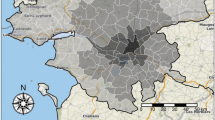Abstract
Mass Rapid Transit (MRT) can greatly improve the accessibility of the area and bring capitalization benefits to the surrounding land value. Due to financial budget constraints, the government often uses Land Value Capture for investment and financing. However, the research on the spatial variations in the influence of MRT on land value improvement at different stages is relatively rare. Therefore, in this paper, the spatial interpolation of Inverse Distance Weighted (IDW) in GIS spatial analysis and the hedonic price model based on ordinary least square (OLS) are used to establish a model based on Geographically Weighted Regression, so as to explore the impact of LRT on residential and commercial land prices along the LRT line from time and space dimensions. The results are: (I) there are significant spatial variations in the influence of Kaohsiung LRT on the land prices along the line at different stages. During the announcement period, the residential land prices will increase by an average of 0.08% for every 1% of the distance near the LRT station within 400 m of the line. In the construction period, the effect of LRT on residential and commercial land prices is basically the same. In the operation period, LRT only has a significant negative impact on residential land prices of the area from the Kaohsiung Exhibition Hall Station (C8) to Hamaxing Station (C14). (II) The GWR models have better local estimation effect than the global regression OLS models, and can better reflect the complex spatial changes.






Similar content being viewed by others
References
Armstrong RJ, Rodríguez DA (2006) An evaluation of the accessibility benefits of commuter railin eastern Massachusetts using spatial hedonic price functions. Transportation 33(1):21–43. https://doi.org/10.1007/s11116-005-0949-x
Chen Y (2014) The impact of kaohsiung mrt's opening on regional house prices—also on the impact of mainland visitors to taiwan. National Central University.
Chen Y, Whalley A (2012) Green infrastructure: the effects of urban rail transit on air quality. Am Econ J Econ Pol 4(1):58–97. https://doi.org/10.1257/pol.4.1.58
Dai G (2012) The reexamination of the impact of metro system on residential housing values in taipei metropolitan. National Chengchi University.
Dziauddin MF (2019) Estimating land value uplift around light rail transit stations in greater kuala lumpur: An empirical study based on geographically weighted regression (gwr). Res Transp Econ 74:10–20. https://doi.org/10.1016/j.retrec.2019.01.003
Fotheringham A, Brunsdon C, Charlton M (2002) Geographically weighted regression: the analysis of spatially varying relationships. Wiley, pp 13.
Li S, Brooks JJ, Jacob J, Ghasemiesfe A, Marrinan GB (2018) Not all sagittal band tears come with extensor instability: a case report with radiological and operative correlation. Skeletal Radiol 47(4):593–596. https://doi.org/10.1007/s00256-017-2820-5
Li S, Lyu D, Liu X, Tan Z, Gao F, Huang G, Wu Z (2020) The varying patterns of rail transit ridership and their relationships with fine-scale built environment factors: big data analytics from guangzhou. Cities 99:102580. https://doi.org/10.1016/j.cities.2019.102580
Malaitham S, Fukuda A, Vichiensan V, Wasuntarasook V (2020) Hedonic pricing model of assessed and market land values: a case study in bangkok metropolitan area, thailand. Case Stud Trans Policy 8(1):153–162. https://doi.org/10.1016/j.cstp.2018.09.008
Medda F (2012) Land value capture finance for transport accessibility: a review. J Transp Geogr 25:154–161. https://doi.org/10.1016/j.jtrangeo.2012.07.013
Mulley C (2014) Accessibility and residential land value uplift: Identifying spatial variations in the accessibility impacts of a bus transitway. Urban Stud 51(8):1707–1724. https://doi.org/10.1177/0042098013499082
Mulley C, Tsai C-H, Ma L (2018) Does residential property price benefit from light rail in sydney? Res Transp Econ 67:3–10. https://doi.org/10.1016/j.retrec.2016.11.002
Shyr O, Andersson D, Wang J, Huang T, Liu O (2013) Where do home buyers pay most for relative transit accessibility? Hong kong, taipei and kaohsiung compared. Urban Stud 50:2553–2568. https://doi.org/10.1177/0042098012474510
Smith JJ, Gihring TA (2006) Financing transit systems through value capture: an annotated bibliography. Am J Econ Sociol 65(3):751–786
So HM, Tse RYC, Ganesan S (1997) Estimating the influence of transport on house prices: Evidence from hong kong. J Prop Valuat Invest 15(1):40–47. https://doi.org/10.1108/14635789710163793
Wang X, Tong D, Gao J, Chen Y (2019) The reshaping of land development density through rail transit: the stories of central areas vs. suburbs in Shenzhen, China. Cities 89:35–45. https://doi.org/10.1016/j.cities.2019.01.013
Yen BTH, Mulley C, Shearer H, Burke M (2018) Announcement, construction or delivery: when does value uplift occur for residential properties? Evidence from the gold coast light rail system in australia. Land Use Policy 73:412–422. https://doi.org/10.1016/j.landusepol.2018.02.007
Zhang J, Wang M (2019) Transportation functionality vulnerability of urban rail transit networks based on movingblock: the case of nanjing metro. Physica A 535:122367. https://doi.org/10.1016/j.physa.2019.122367
Zhao L, Shen L (2019) The impacts of rail transit on future urban land use development: a case study in Wuhan, China. Transp Policy 81:396–405. https://doi.org/10.1016/j.tranpol.2018.05.004
Funding
National Natural Science Foundation of China, Research on urban public service facilities reconfiguration in the Information Era—Case studies on Guangzhou and Fuzhou, No. 41801160; Open project State Key Laboratory of Subtropical Building Science, Spatial evolution and planning control of public service facility distribution based on Big data analysis, No.2020ZB12.
Author information
Authors and Affiliations
Corresponding author
Ethics declarations
Conflict of Interest
The authors declare no conflicts of interest.
Additional information
Publisher's Note
Springer Nature remains neutral with regard to jurisdictional claims in published maps and institutional affiliations.
Supplementary Information
Below is the link to the electronic supplementary material.
Rights and permissions
About this article
Cite this article
Shi, M., Su, Q. & Zeng, X. Estimating the Effects of Light Rail Transit (LRT) on Land Price in Kaohsiung Using Geographically Weighted Regression. Transp. in Dev. Econ. 8, 9 (2022). https://doi.org/10.1007/s40890-021-00147-y
Received:
Accepted:
Published:
DOI: https://doi.org/10.1007/s40890-021-00147-y




